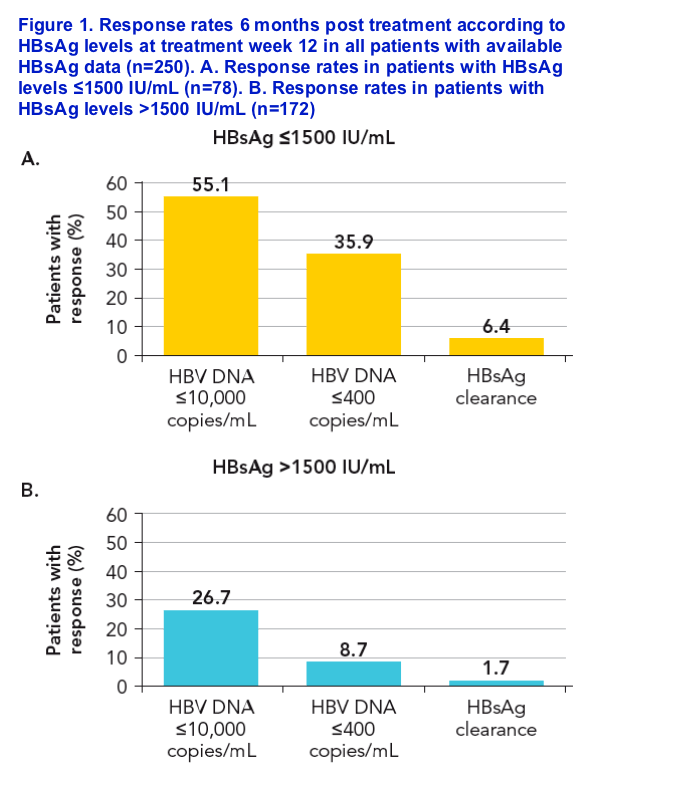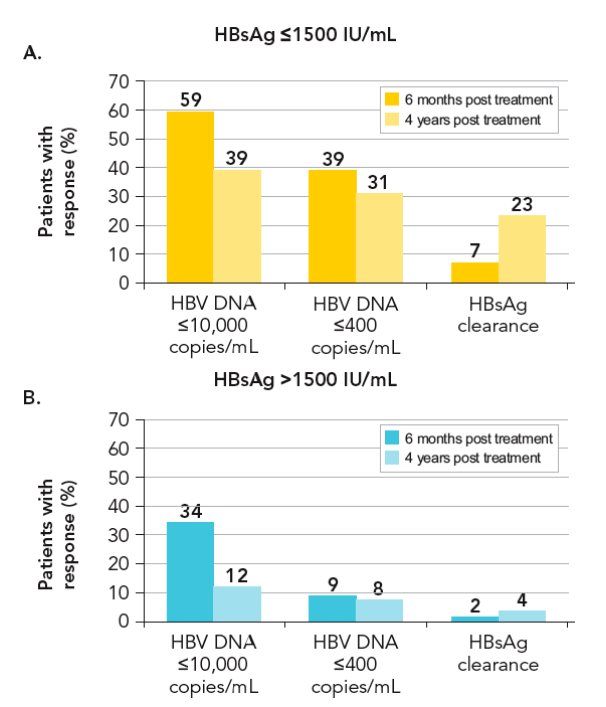 |
 |
 |
| |
In Patients With HBeAg-Negative Chronic Hepatitis B, HBsAg Serum Levels Early During Treatment With Peginterferon Alfa-2a Predict HBsAg Clearance up to 4 Years Post-Treatment
|
| |
| |
Reported by Jules Levin
59th Annual Meeting of the American Association for the Study of Liver Diseases, October 31 - November 4, San Francisco, USA
P Marcellin,1 M Brunetto,2 F Bonino,3 S Hadziyannis,4 H-P Kapprell,5 P McCloud,6 R Batrla7
1Service d'Hepatologie and Centre de Recherches Biologiques Bichat Beaujon (Inserm CRB3), Clichy, France; 2UO Epatologia, Azienda Ospedaliero Universitaria Pisana, Pisa, Cisanello, Italy; 3Direzione Scientifica, Policlinico de Milano,
IRCCS, Milano and UniversitÓ di Pisa, Milano, Italy; 4Henry Dunant Hospital, Athens, Greece; 5Abbott GmbH & Co, Wiesbaden, Germany; 6Roche Products Pty Ltd, Dee Why, NSW, Australia; 7Hoffmann-La Roche Ltd, Basel, Switzerland
BACKGROUND
HBsAg clearance or seroconversion (loss of HBsAg and appearance of anti-HBs) can be considered the closest we can achieve to clinical cure of chronic hepatitis B infection
We demonstrated that HBsAg clearance could be achieved in patients with HBeAg-negative disease following 48 weeks treatment with peginterferon alfa-2a ± lamivudine, but not in those treated with lamivudine alone1
In a long-term observational follow-up study we found that the rate of HBsAg clearance in patients treated with peginterferon alfa-2a ± lamivudine increased from 3%, 6 months post treatment, to 11%, 4 years after the end of treatment2
Data presented recently have shown that patients treated with a 48-week course of peginterferon-alfa-2a, with or without lamivudine, can induce a marked decline in HBsAg which is sustained 6 months post treatment. This decline in HBsAg was not achieved by lamivudine monotherapy treatment. In patients who had HBV DNA levels suppressed <400 copies/mL 6 months post-treatment, mean HBsAg levels at this time point were markedly reduced in patients treated with a peginterferon alfa-2a-containing regimen (mean HBsAg reduction from baseline 1.5 log10 IU/mL), but not in the patients receiving lamivudine (mean reduction from baseline <0.1 log10 IU/mL), despite the same degree of HBV DNA suppression3
There is an indication that quantitative HBsAg analysis may be a useful marker of the patient's response to therapy4
We observed previously that levels of HBsAg at the end of treatment were associated with HBsAg clearance 3 years post treatment in patients treated with peginterferon alfa-2a ± lamivudine5
Identification - during the early stages of therapy with peginterferon alfa-2a - of patients most likely to respond and subsequently clear HBsAg following treatment would be desirable and of clinical relevance to the treating physician
OBJECTIVE
To identify the potential association between early (week 12) on-treatment HBsAg levels and response (HBV DNA suppression and HBsAg clearance) to peginterferon alfa-2a ± lamivudine in patients with HBeAg-negative disease
AUTHOR SUMMARY
HBsAg level at week 12 was significantly associated with response to peginterferon alfa-2a ± lamivudine both 6 months and 4 years post treatment
Analysis of HBsAg levels at treatment week 12 identified a subgroup of patients with a high rate of post-treatment response
-- Patients with an HBsAg level of ≦1500 IU/mL at week 12 had a 23% chance of HBsAg clearance 4 years post treatment
In contrast, patients with an HBsAg level >1500 IU/mL at treatment week 12 have a rather modest probability of long-term virologic response
AUTHOR CONCLUSION
Quantification of HBsAg level at week 12 could be a useful early predictor of off-treatment response to peginterferon alfa-2a-based therapy. Patients with low HBsAg levels at week 12 had the best rates of response 6 months and 4 years post treatment. One of the limitations of our study has been the fact that not all the patients enrolled in the initial study had quantitative HBsAg measurements at week 12 and long-term follow up data. Therefore, further study is required to optimize the week 12 cut-off level to provide a clinically useful negative predictive value
METHODS
The results of the initial study have been reported previously.1 Patients (n=537) were randomized to receive 180 _g/week peginterferon alfa-2a (40KD; PEGASYS) plus oral placebo daily (n=177), peginterferon alfa-2a 180 _g/week plus 100 mg/day lamivudine (n=179) or lamivudine 100 mg/day (n=181) for 48 weeks
All participating centers in the initial study were invited to participate in a long-term observational follow-up protocol (long-term study), in which patients were followed for up to 4 years after completing treatment
Quantitative HBsAg in serum was measured pre-treatment, on-treatment (weeks 12, 24 and 48) and post treatment (week 72) using the Abbott Architect HBsAg assay in available stored sera
Of the 356 patients treated with peginterferon alfa-2a ± lamivudine in the initial study, a total of 250 patients had sera available at week 12 of therapy. Of the 250 patients with available week 12 sera, 156 entered the long-term follow-up study
The association between HBsAg level at week 12 and subsequent response both at 6 months and 4 years post treatment was determined. Response parameters were: HBV DNA ≦10,000 copies/mL, HBV DNA ≦400 copies/mL and HBsAg clearance. In all analyses, patients with missing data for response parameters were considered as non-responders
RESULTS
Patients and serum samples
In an initial analysis, sera from 160 patients were available for HBsAg quantification at week 12. Analysis of these samples showed that the rate of HBsAg clearance 4 years post treatment was significantly higher for patients with week 12 HBsAg levels ≦1500 IU/mL than for those with week 12 HBsAg levels >1500 IU/mL (35% vs 3%; P<0.001; data shown in abstract)
The rates of HBsAg clearance for the initial 160 patients analyzed were 4.4% and 11.3% at 6 months and 4 years post treatment, respectively
Week 12 HBsAg data have now been determined for an additional 90 patients
We present here the overall analyses for the 250 patients with available week 12 HBsAg data, 156 of whom entered the longterm follow-up study
Demographics
Patients with available HBsAg data at week 12 of treatment (n=250) were included in the current analysis
-- 126 were treated with peginterferon alfa-2a and 124 were treated with peginterferon alfa-2a + lamivudine
The 250 patients with available sera at week 12 were predominately male (79%) and the mean age at baseline was 42 years
The HBV genotype distribution among these patients was as follows: genotype A=8.4%; genotype B=13.6%; genotype C=32.4%; genotype D=42.8%; other genotype=2.8%
Efficacy analyses
Rates of response in patients treated with peginterferon alfa-2a alone or in combination with lamivudine in the overall study were similar. Therefore, for the purpose of this analysis, data for these two groups were pooled
Response rates 6 months post treatment according to HBsAg levels at week 12 - all patients with available week 12 HBsAg data (n=250)
The rates of response 6 months post treatment for all 250 patients with available HBsAg data at week 12 were: 36% for HBV DNA ≦10,000 copies/mL, 17% for HBV DNA
≦400 copies/mL and 3% for HBsAg clearance
Figure 1 shows the response rates for these patients according to HBsAg level at treatment week 12
The highest rates of response were seen in patients with week 12 HBsAg levels ≦1500 IU/mL (Figure 1A). Patients with these HBsAg levels represented 31% of all patients with available HBsAg data
The patients with HBsAg levels at treatment week 12 >1500 IU/mL had significantly lower rates of HBV DNA response 6 months post treatment (Figure 1B). The corresponding P values for HBV DNA ≦10,000 copies/mL, ≦400 copies/mL and HBsAg clearance were <0.001, <0.001 and 0.112, respectively

Response rates 6 months and 4 years post treatment for
patients participating in the long-term study according to
HBsAg levels at week 12
The rates of response 4 years post treatment for all 156 patients with available HBsAg data at week 12 participating in the longterm study were 22% for HBV DNA ≦10,000 copies/mL, 17% for HBV DNA ≦400 copies/mL and 12% for HBsAg clearance
Patients with HBsAg levels ≦1500 IU/ml at week 12, who represented 39% of the patients assessed, had the highest rates of response for all three virologic parameters at both 6-month and 4-year post-treatment follow-up assessments (Figure 2A)
Patients with HBsAg levels at treatment week 12 >1500 IU/mL had significantly lower rates of response 4 years post-treatment (P<0.001 for all three comparisons, Figure 2B)
These data indicate that an HBsAg cut-off of 1500 IU/mL at week 12 resulted in a positive predictive value of 39%, 31% and 23% for achieving HBV DNA levels ≦10,000 copies/mL, ≦400 copies/mL and HBsAg clearance 4 years post treatment
The corresponding negative predictive values were 88%, 92% and 96%, respectively


REFERENCES
1. Marcellin P et al. Peginterferon alfa-2a alone, lamivudine, and the two in combination in patients with HBeAg-negative-chronic hepatitis B. N Engl J Med 2004;351:1206-7
2. Marcellin P et al. Virological and biochemical response in patients with HBeAg-negative chronic hepatitis B treated with peginterferon alfa-2a (40KD) with or without lamivudine: results of 4-year follow-up. J Hepatol 2008;48(suppl 2):S46
3. Brunetto M et al. HBV DNA suppression induced by peginterferon alfa-2A (40KD), but not by lamivudine, results in HBsAg loss and seroconversion at 3 years post treatment. J Hepatol 2008;48 (suppl 2):S254
4. Janssen HL et al. Measurement of HBsAg to monitor hepatitis B viral replication in patients on alpha-interferon therapy. Antiviral Res 1994;23: 251-7
5. Marcellin P et al. Long-term follow-up of HBsAg clearance in patients with HBeAg-negative CHB treated with peginterferon alfa-2a: increase in HBsAg clearance rate from 3% 6 months post treatment to 8% after 3 years. Hepatology 2007;46(suppl 1):673A (Abstract 979)
Disclosure Information
This research was funded by F. Hoffmann-La Roche Ltd, Basel, Switzerland
|
| |
|
 |
 |
|
|